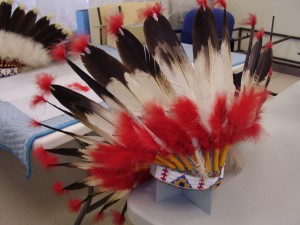There are many posts on this blog about the HMNS collections, especially those objects that are being highlighted by the curators for the centennial. Acquiring objects – whether by donation, exchange or purchase – is part of the mission for most museums. But mere acquisition of artifacts isn’t the only purpose of collections; a museum must also conserve and care for the objects already in their possession.
The mission statements of an overwhelming majority of museums in this country include something along the lines of educating and informing the public about science, history, art or whatever field that particular museum specializes. Museum collections aid that mission through exhibition, research or a combination of both. Acquiring a bunch of stuff then letting it fall into a state of irreversible disrepair is neither practical nor ethical. Museums must take care of their collections for the greater good of the public.
It’s a harder job than one might casually think. Objects must be exhibited and stored in the proper climate (both temperature and humidity) and kept secure from theft, vandalism and other harm. That’s why museum facility managers spend countless hours fussing over HVACs and alarms. Yet, despite all best efforts, sometimes stuff just happens. There’s a myriad of scenarios but to the rescue comes the museum collections hero or heroine, the conservator.
 |
| A conservator removes adhesive from textiles |
Conservators are flat out some of the smartest, nicest, calmest people you’ll ever meet. To paraphrase Will Rogers, ‘I’ve never yet met one I didn’t like.’ So who are these folks? Well, to start with they’re highly educated, trained and skilled. After all, they work with irreplaceable, highly-valued objects; you won’t find crazy glue, scotch tape or duct tape among their work tools. They have a deep background in organic chemistry so they can understand the nature of the object, the damage done and the proper treatment. Conservators know and/or can puzzle out the chemical and mechanical reactions of an object to a treatment such as adhesive, paint, or physical support. In addition to what they already know, they’re constantly updating their knowledge of the chemical make-up of the latest paint, adhesives, inks, paper, etc. The science of object conservation is amazing!
 |
| Our conservator works on building a proper support for a headdress |
Professional conservators also adhere to strict ethical codes. Like medical doctors they believe in ‘first, do no harm.’ Any treatment that a conservator employs must be the possible best for the object at present and (with any luck) into the future. Most conservation work is deliberately designed to be obvious and reversible. Sounds counter-intuitive at first but here’s the logic.
Object conservation is continuously improving, so that the treatment today is currently the best. But we know that the future will bring even better technology and tools. Should an object need more work in the future that conservator must be able to see where and how past treatment was done in order to remove it and apply better methods. Staying in the present, current museum collections staff must be able to see where an object has been repaired and might still be vulnerable so as not to further damage the piece.
Now, I hasten to add that this doesn’t necessarily mean that conservation work will be so glaringly obvious as to detract from the object. Good conservation treatments are quite often hardly noticeable at all to the untrained eye so that an object can be exhibited. The conservation work shows just enough so that museum staff can see how to handle the object properly. There are also many times when damage can be completely removed leaving the object in even better condition than its previous state.
All this hardly scratches the surface of our collections’ heroes: the conservators. If you want to know more or if you have an artifact or specimen that needs some conservation check, out these websites and books:
http://www.conservation-us.org/
http://www.io.com/~tam/Resources/conservator.html
http://www.winterthurstore.org/the-winterthur-guide-to-caring-for-your-collection.html
Also check out Caring for Your Family Treasures: Heritage Preservation: A Concise Guide to Caring for Your Cherished Belongings by Jane S. Long and Richard W. Long






